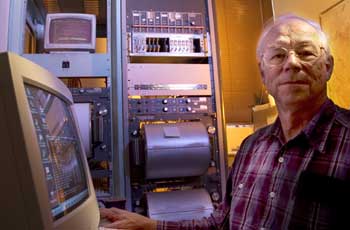Northern Arizona University is on a new team to boost the state’s ability to monitor earthquake hazards.
Scientists from NAU, Arizona State University and the University of Arizona are working with the Arizona Geological Survey to purchase and maintain eight broadband seismometer stations that “will enhance the state’s capability to reliably, accurately and quickly report earthquake monitoring information,” said David Brumbaugh, a geology professor at NAU.
A nearly $500,000 Pre-Disaster Mitigation Competitive Grant from the Federal Emergency Management Agency will provide the funds to buy and maintain the sophisticated earth-monitoring equipment, which will improve seismic analysis throughout the state and will help Arizona build its first nationally integrated seismic network.
“The machines will increase the seismic coverage presently available from the northern Arizona network operated by the Arizona Earthquake Information Center at NAU,” Brumbaugh said. “We will greatly improve earthquake monitoring of tremors with better detection and location of events now too small to provide critical data.”
He said small earthquakes that are generally undetected in Arizona now, may offer clues to where larger earthquakes could occur in the future.
“Monitoring of seismic signals from large earthquakes around the world as they pass through Arizona also helps us understand where faults or other anomalies lie undetected in the subsurface,” he said.
Brumbaugh said that at this point, scientists reliably could not predict a significant magnitude 5-6 tremor in Arizona. “We have had them, so we can say we can expect more,” he explained. “We simply do not have enough data yet to be comfortable about accurately stating the odds of a damaging earthquake.”
Significant earthquakes affecting northern Arizona occurred in 1906, 1910, 1912, 1959 and 1993.
The grant, administered by the Arizona Division of Emergency Management, also will further cooperation among the Arizona’s geoscientists. Historic monitoring of earthquakes in Arizona has been hampered by lack of a coordinated, statewide, seismic network, said Mimi Diaz, from the Arizona Geological Survey’s Phoenix branch. Until now.
“The amount of cooperation for this project is staggering. Besides the two state agencies and three universities, 14 of the state’s 15 counties are working together to make this project possible,” Diaz said.



